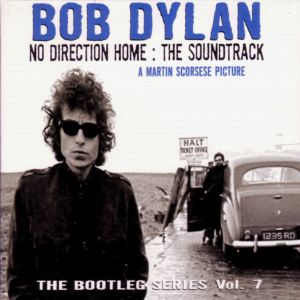
- Format: MP3

The seventh volume of Bob Dylan's Bootleg Series doubles as the soundtrack to No Direction Home, Martin Scorsese's feature-length documentary covering Dylan's career from its beginnings to 1966 (it was aired in two parts on PBS in September 2005 and released in expanded form on DVD that same month). Unlike the previous three installments of The Bootleg Series, which focused exclusively on live concerts, No Direction Home is assembled from a variety of sources, including home recordings, publishing demos, alternate studio takes, and live recordings, with the first disc devoted to early acoustic recordings and the second to electric music. In fact, No Direction Home proceeds chronologically, filling in gaps between the proper albums or, more often, providing a parallel history of the most productive era of Dylan's career. All of this material — with the exception of "Song to Woody," taken from his debut, and a cataclysmic version of "Like a Rolling Stone" taken from the Royal Albert Hall show that was released as The Bootleg Series, Vol. 4 — is previously unreleased, and much of it has not been widely bootlegged (and the cuts that have been bootlegged, such as "Dink's Song," have never been heard in such crystal-clear fidelity). Where the inaugural edition of The Bootleg Series had many previously unreleased Dylan originals, there is only one here, the tentative opener, "When I Got Troubles," a sweet, simple 1959 song that finds Dylan in his formative stage. In place of unheard songs are a slew of alternate versions of familiar tunes. On the first disc, these are largely live versions of such warhorses as "Blowin' in the Wind," "Masters of War," and "A Hard Rain's a-Gonna Fall," recorded when the songs were still fresh. These live performances have an immediacy and intimacy that not only illustrate what a powerful folksinger Dylan was, but also suggest how the songs might have sounded when they were new tunes. Toward the end of the first disc, alternate versions that are significantly different from the final versions begin to surface with an early take on "Mr. Tambourine Man" recorded at the Another Side of Bob Dylan sessions with Ramblin' Jack Elliott on second guitar and backing vocals. The second disc has several alternates that are similarly notably different, highlighted by a lively, careening "It Takes a Lot to Laugh, It Takes a Train to Cry" with a different final verse, a "Desolation Row" with electric guitar, "Highway 61 Revisited" without the siren whistle, a slower, heavier, blusier take on "Leopard-Skin Pill Box Hat," a relaxed version of "Stuck Inside of Mobile with the Memphis Blues Again" that lacks the carnivalesque swirl of sound from the Blonde on Blonde version, and a lean, insistent "Visions of Johanna."
As different as some of these versions are, there are no great revelations here, apart from the realization that the best takes really did make the finished records. But looking for revelations on this seventh edition of The Bootleg Series may be setting the bar too high, particularly because even if few things here are earth-shaking (a rampaging "Maggie's Farm" from Dylan's legendary electric set at the Newport Folk Festival in 1965 could qualify, thanks in great deal to an incendiary Mike Bloomfield), everything here is uniformly excellent and worth hearing well more than once. That alone, of course, would make this yet another worthwhile addition to any serious Dylan collection, but what makes No Direction Home noteworthy as an album is that it is the first Dylan record to offer an aural biography of Dylan. This does a superb job of tracing the development of Dylan as a musician, taking him from a young folkie singing standards, through the rush of his early standards, and to the visionary music he made once he went electric. Put in this context, the electric music on disc two sounds as bracing and brilliant and surprising as it did in the '60s, while the acoustic folk on disc one sounds vibrant, pure, and alive. After all these years, that's a hard accomplishment to pull off, and to the credit of everybody involved in this terrific release, they've been able to make even the most familiar Dylan tunes feel new again.